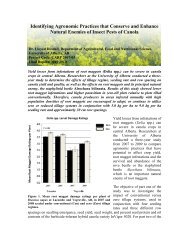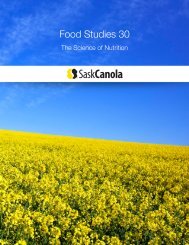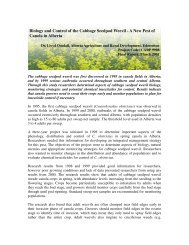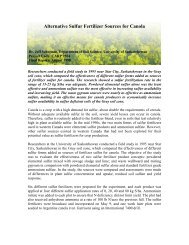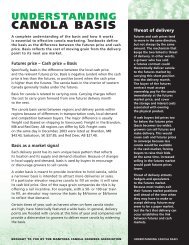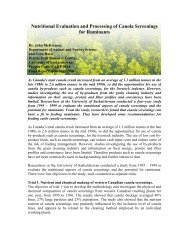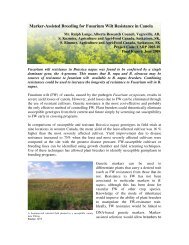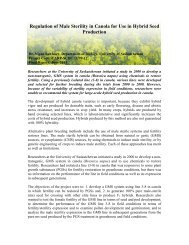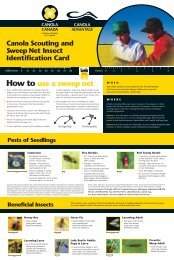Canola Digest, January 2013 - SaskCanola
Canola Digest, January 2013 - SaskCanola
Canola Digest, January 2013 - SaskCanola
You also want an ePaper? Increase the reach of your titles
YUMPU automatically turns print PDFs into web optimized ePapers that Google loves.
When asked what he does to get the<br />
most out of his land, Visscher highlights<br />
his seeding process. “We have<br />
a good drill, a John Deere 1870 with<br />
independent openers, we keep canola<br />
seeding depth at 0.5 to 0.75 inches, we<br />
seed at the right temperature – not too<br />
early, and we apply the recommended<br />
fertilizer rates,” he says. “We’ve also<br />
been zero till for 10 years.”<br />
Visscher’s fertilizer program aims<br />
to match rates and blends with yield<br />
variability from field to field and<br />
within each field. “We started easing<br />
into variable rate technology three<br />
years ago, and we’ll be doing almost<br />
all our acres in <strong>2013</strong>,” he says. He has<br />
two carts for his drill – a tow between<br />
and a tow behind – so he can carry<br />
all fertilizer components separately.<br />
Everything is blended on the go, as<br />
prescribed by his variable rate maps.<br />
Colin Bergstrom, president and<br />
precision farming consultant with<br />
Point Forward Solutions in St. Albert,<br />
Alberta, develops Visscher’s variable<br />
rate prescriptions based on field<br />
electrical conductivity (EC) measurements,<br />
topography and soil tests.<br />
“The Legal area has some of the best<br />
land within Risk Zone 11. Growers<br />
will often get canola that yields near<br />
60 bu./ac., and they’re usually<br />
disappointed with yields in the 40s,”<br />
Bergstrom says. But he adds that even<br />
in that good area, localized solonetzic<br />
areas make some fields quite variable<br />
in productivity. “In those areas that<br />
only produce half a crop, we fertilize<br />
accordingly to lower the risk.”<br />
SASKATCHEWAN, RISK ZONE 18<br />
The top yielding region for canola in<br />
Saskatchewan, based on Saskatchewan<br />
Crop Insurance Corporation (SCIC) data,<br />
is Risk Zone 18, which does a big ring<br />
around Saskatoon. The next best are<br />
Zones 23, 22 and 20, all in the northwest.<br />
A quick calculation puts the 2007-11<br />
average canola yield for Zone 18 in the<br />
range of 36 to 39 bu./ac.<br />
Brett Galambos works with Wendland<br />
Ag in Waldheim in the R.M. of Laird<br />
(#404) in the northwest of Zone 18.<br />
The R.M. is between the North and<br />
South Saskatchewan Rivers, Canada’s<br />
version of the historic Fertile Crescent<br />
of Mesopotamia – “the land between<br />
two rivers.”<br />
Galambos says rich black soil is the<br />
biggest reason for good yield potential<br />
in his area. Organic matter is four to<br />
five percent and pH is slightly acidic.<br />
They also get favourable rain for the<br />
most part, which helps even marginal<br />
land “put out just like black soil,”<br />
Galambos says. Finally, he credits farm<br />
management. “Guys have caught on to<br />
the fact they’ve got good dirt, and they<br />
know which fields they can push harder<br />
than others.”<br />
<strong>Canola</strong> Average Yields by Prairie Province (bu./ac.)<br />
Steve Visscher (right) with his son, Dane, at the CCC Combine Clinic in Westlock in 2010.<br />
Visscher says he gets the most out of his land by seeding shallow, not seeding too early and<br />
applying fertilizer at variable rates.<br />
2008 2009 2010 2011 2012 5-year avg<br />
Manitoba 36.9 39.9 31.4 27.8 25.9 32.4<br />
Saskatchewan 32.5 35.2 30.9 32.9 25 31.3<br />
Alberta 36.9 32.7 38 39 34.9 36.3<br />
Canada 34.7 35.3 33.3 34.2 28.3 33.2<br />
Source: Agriculture and Agri-Food Canada, Market Analysis Group<br />
This leads to high expectations.<br />
“If they’ve had a poor crop for a couple<br />
years, they start to think ‘maybe I’m<br />
missing something,’” he says. “As a<br />
result, pay-per-field or pay-per-hour<br />
agronomy work has seen big growth<br />
in the area in the past five years.”<br />
Wilmer Froese farms near the village<br />
of Laird and is a Wendland client.<br />
Galambos says Froese’s land is some of<br />
the best in the R.M. “We certainly have<br />
had good results,” says Froese.<br />
But even the best land in a very good<br />
R.M. has variability. “I recognize that<br />
certain fields are better than others,”<br />
he says. He has one quarter that is<br />
exceptional, this year yielding almost<br />
five bu./ac. more than his others. Another<br />
on higher ground has more rocks and<br />
had lower potential. However, he’s been<br />
hauling manure onto that field, which<br />
“has improved productivity a lot.”<br />
Froese credits technology, especially<br />
new varieties, for an overall rise in<br />
production. “We couldn’t grow 60-bushel<br />
canola crops 10 years ago,” he says.<br />
Zero tillage and good equipment are<br />
other factors. He bought a new drill this<br />
year and took it to a nearby Hutterite<br />
Colony for leveling. “They put it on a<br />
large concrete pad and leveled the drill<br />
shank by shank. Individual runs varied<br />
by up to an inch from one to the next,”<br />
he says. This is huge when you’re trying<br />
to seed canola consistently at 0.5 to<br />
one inch deep.<br />
“A neighbour came by and said, “Your<br />
canola is so even,” and it’s all because<br />
my drill is level,” says Froese. “It cost me<br />
$1,100 but it was well worth it.”<br />
continued on page 19<br />
17<br />
CANOLA DIGEST JANUARY <strong>2013</strong>



